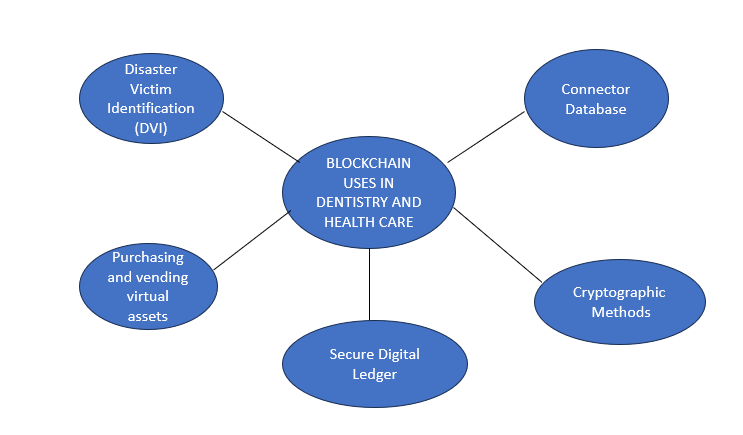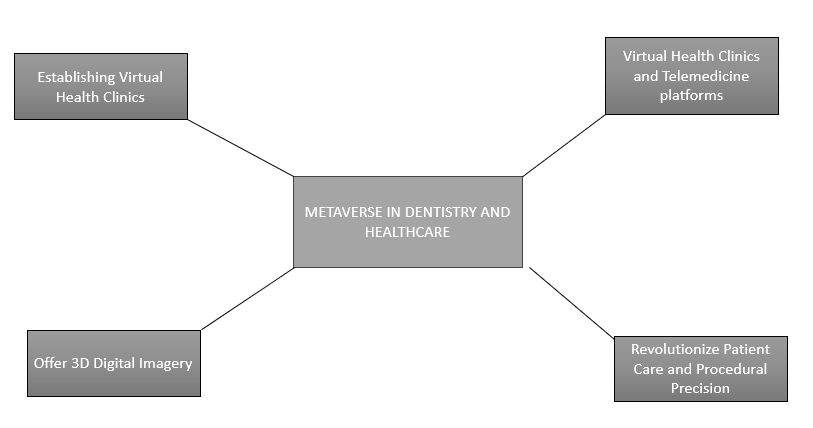Introduction
The current era, the 21st century, has emerged as a period characterized by groundbreaking technologies and advancements, encompassing digitalization and the implementation of industry. These digital innovations have now taken on a crucial role in virtually every facet of our day-to-day existence. Their pervasive influence spans across almost all sectors, progressively intensifying their effects. Within this landscape, the field of dentistry stands as an economic sector poised to experience substantial advantages through the integration of digital technologies.1 The seamless integration of technologies like blockchain, the metaverse, cryptocurrencies, and NFTs is revolutionizing education and the sharing of knowledge. Moreover, it facilitates the dissemination of personalized healthcare information tailored to the unique requirements of each individual patient.2
Blockchain rose to prominence as a distributed ledger technology subsequent to the release of the Bitcoin white paper in October 2008.3 One year following the issuance of the renowned Bitcoin white paper, the Bitcoin cryptocurrency was actualized, its code being made available as open-source. This allowed for the modification and enhancement of the code by others, leading to the development of various iterations of blockchain-based technologies. These initial applications of blockchain-based cryptocurrencies, including Bitcoin, marked the inception of the first generation of blockchain technology, often denoted as blockchain 1.0.4 Implementing smart contracts to bring Decentralized applications (Dapps), Decentralized Autonomous Organizations (DAOs), Intelligent property, Dynamic tokens, and more to life has paved a pathway toward automated financial applications founded on cryptocurrencies. These groundbreaking financial applications, enabled by the fusion of smart contracts and digital currencies, collectively fall under the umbrella term "Blockchain 2.0." This nomenclature encompasses the innovative landscape where smart contracts and digital currencies converge to catalyze novel financial possibilities.
Blockchain technology applications that extend beyond cryptocurrency-related use cases and encompass a broader range of distributed ledger applications are commonly classified as Blockchain 3.0 applications. It's important to recognize that while these applications are conceptually distinct from cryptocurrencies, they can still derive advantages from integration with them. In practice, they are frequently implemented on blockchain platforms rooted in cryptocurrencies like Bitcoin or Ethereum. Blockchain 3.0 signifies the process of transferring the attributes achieved through blockchain's trustless decentralization, such as immutability, transparency, and elimination of intermediaries, to other systems built upon blockchain technology. This transition reflects the expansion of blockchain's foundational principles to enhance various systems that utilize this technology.5
Neal Stephenson, a British science fiction author, introduced the term "Metaverse" in 1992 to describe an internet-based virtual world. Over time, this concept has transformed into a network of expansive computer-generated realms. A Google search currently yields over 200 million results on the topic, and Goldman Sachs has projected the metaverse to present an $8 trillion opportunity. This metaverse exists on the internet and comprises virtual users (Avatars), residences, streets, and properties.6 The metaverse offers a pathway to enter an ethereal realm, granting users access to unprecedented experiences that might seem unattainable in the tangible world. Informally, the metaverse constitutes a three-dimensional network of virtual domains, placing emphasis on social and economic interactions. In conjunction with the Internet of Things, cloud computing, augmented reality, and quantum computing, this fantastical notion of the metaverse has also made inroads into the realm of healthcare.7 Education has evolved into the cornerstone of human progress. Historically, pivotal shifts in education have marked significant advancements in civilization. The initial transformative moment was the introduction of writing systems, followed by the establishment of communal learning, and subsequently, the transition to online group education. Forecasts suggest that a fourth educational revolution is on the horizon, characterized by personalized learning experiences catering to individual aptitudes and accomplishments. This revolution is anticipated to leverage cutting-edge technologies like Artificial Intelligence (AI), Blockchain, and the metaverse. 8
Blockchain Uses in Dentistry and Health Care
Anveshan, a connector database, was created specifically for the Indian state of Gujarat. Its primary objectives were to: (A) Address the issue of fragmented data; (B) Facilitate comprehensive analysis for monitoring dynamic data trends; (C) Monitor alterations in data; and (D) Establish fault tolerance, ensuring the accurate preservation of data over extended durations. While conducting real-time piloting was hindered by the COVID-19 pandemic, a simulated pilot was conducted. The resulting report encompassed insights gained, advantages and obstacles encountered when employing blockchain for immunization documentation, along with suggestions for its prospective application. 9 Leveraging blockchain technology and the Internet of Things (IoT) allows secure storage of vital dental information, ensuring privacy and data security, and enabling accurate disease prognosis. As healthcare shifts towards personalized patient care, precise evaluation of individual dental conditions will aid clinicians in decision-making, prevention, and therapy. Another aspect of blockchain's potential is for dentists to input comprehensive treatment details, including diagnosis, clinical findings, decisions, materials used, and the treatment process, into the blockchain system. 2
Through increased ownership and management of their health records, individuals can actively engage in their treatment choices, resulting in more tailored and efficient dental care. Blockchain technology introduces further advantages and opens novel opportunities for patient involvement in dental healthcare. Utilizing blockchain, patients gain enhanced authority over their medical information. They can securely store these records on the blockchain and grant access to healthcare practitioners as required. Blockchain's cryptographic methods ensure the confidentiality and security of patient data. By utilizing encryption and decentralized storage, blockchain technology can safeguard sensitive data against unauthorized access and potential breaches. Moreover, blockchain enables the sharing of treatment strategies and medical histories among healthcare providers participating in patient care, fostering improved coordination, collaboration, and decision-making within the dental and broader medical community. 10
The rise in mass disasters has led to an increasing number of unidentified victims globally, posing challenges for Disaster Victim Identification (DVI) teams. Victim identification involves comparing Ante-Mortem (AM) and Post-Mortem (PM) records based on primary identifiers like DNA, fingerprints, and teeth. Despite INTERPOL standards advocating the use of all available identifiers, teeth are considered the most durable and resilient, often surviving burial. However, inconsistent dental coding across countries, inadequate AM dental records, and the absence of digital formats pose significant obstacles, delaying timely victim identification. Blockchain employs qualitative and quantitative approaches to outline the prerequisites for a comprehensive dental data record and harmonized ecosystems. It proposes a system design model that automates the conversion of divergent primary dental records into DVI INTERPOL-compliant formats, storing them in a blockchain-based distributed ledger. This accessible ledger aids international DVI teams in bringing closure to families of victims worldwide.11
Blockchain functions as a secure digital ledger, resistant to modification, while Non-Fungible Tokens (NFTs) are distinctive digital markers stored on a blockchain, enabling sale and trade. Additionally, blockchains facilitate cryptocurrencies usable within the Metaverse for purchasing and vending virtual assets like dental materials, artwork etc. (7) (Figure 1)
Metaverse in Dentistry and Healthcare
Expanding on its capabilities, the Metaverse has the capacity to enhance health and wellness promotion, particularly in areas grappling with limited healthcare resources. By establishing virtual health clinics and telemedicine platforms, individuals in remote or underserved regions can gain access to medical professionals and valuable healthcare content. Furthermore, the Metaverse can serve as a platform for crafting virtual wellness programs, encompassing activities like fitness classes and meditation sessions, universally accessible to individuals across the globe. This potential to promote well-being within the Metaverse holds significant promise for transforming healthcare accessibility and fostering healthier lifestyles. 12
Anticipating future developments, dentistry is poised to undergo transformation inspired by medical health practices within the metaverse. In the near future, dental telehealth interactions might occur within a virtual metaverse, where avatars engage in dental health consultations with patients. Envision scenarios such as conducting a root canal using real-time X-rays or 3D images of canal structures, performing implant procedures while observing precise implant and bone positioning during surgery, or even removing tumor growths with live visualizations of anatomical extensions. The convergence of dentistry and the metaverse holds the potential to revolutionize patient care and procedural precision. 13
With its capacity to offer 3D digital imagery, this technology holds significant potential in dentistry, offering a foundation for enhancing dental procedures and addressing forthcoming healthcare demands. The application of the Metaverse in dental services, encompassing diagnostics, treatments, and education, merits specific consideration. Further exploration in this domain is recommended, given its emergence as a novel research avenue. This technology stands to reshape dentistry, aligning with future healthcare requirements. 14
Metaverse’s, Artificial Intelligence, Cryptocurrency and Blockchain’s role in dentistry is a testament to the ever-expanding possibilities of technology in healthcare. By embracing and furthering our understanding of its capabilities, we stand on the cusp of a new era in healthcare, where the boundaries of physical presence are transcended, and the potential for improved health and well-being knows no bounds. 15 (Figure 2)
Discussion
The integration of blockchain technology and the metaverse into the field of dentistry presents exciting possibilities and challenges. Let's delve into the potential impact and implications of these innovations.
Blockchain's cryptographic methods offer a secure means of storing and sharing dental records, ensuring patient data privacy. This can be especially crucial in healthcare, where confidentiality is paramount. Giving patients control over their health records can lead to more personalized and efficient care. Blockchain's potential to assist international DVI teams in identifying victims of mass disasters is a novel application.
NFTs in healthcare offer potential in data ownership, clinical trials, credential verification, and organ tracking. However, privacy, security, and regulatory concerns must be carefully addressed. Continuous monitoring is essential for emerging applications and use cases in this sensitive industry.
The introduction of cryptocurrency into healthcare might also ease borderless telemedicine payments, safe patient data sharing, and patient identification verification. Nonetheless, strict compliance to data protection laws and industry standards, as well as strict cybersecurity measures, must be taken to safeguard sensitive health information and assure the integrity of healthcare transactions.
The metaverse's potential to establish virtual health clinics and telemedicine platforms could bridge healthcare gaps in underserved regions. The prospect of conducting dental procedures within a virtual metaverse opens new horizons. Exploring the application of the metaverse in dental diagnostics, treatments, and research is a promising avenue. The metaverse could also become a powerful tool for dental education and training.
In summary, Blockchain, Cryptocurrency, NFTs and the Metaverse have the potential to revolutionize dentistry and healthcare by enhancing data security, patient empowerment, disaster victim identification, and the delivery of dental services. However, these innovations also come with technical, ethical, and practical challenges that need careful consideration and collaboration among dental professionals, technology experts, and policymakers. The future of dentistry in the digital age holds great promise, and the discussion around these topics is essential to harness their full potential while addressing associated concerns.
Conclusion
In conclusion, the fusion of blockchain technology and the metaverse with the field of dentistry and healthcare represents an exciting frontier in the evolution of healthcare systems. These innovations have the potential to revolutionize how we handle patient data, deliver healthcare services, and promote overall well-being. Blockchain's strengths in data security and patient empowerment are poised to create a paradigm shift in healthcare. Patients gaining control over their medical records can lead to more personalized and effective treatment plans. Moreover, block chain's applications in Disaster Victim Identification (DVI) offer a humanitarian dimension, helping bring solace to families in times of tragedy. The metaverse, with its virtual health clinics and telemedicine platforms, can break down geographical barriers, providing healthcare access to remote and underserved populations. It's potential for real-time, immersive dental procedures and diagnostics represents a leap forward in precision and accessibility. However, as with any transformative technology, challenges loom on the horizon. Ethical considerations related to data privacy and security demand rigorous attention. Regulatory frameworks must evolve to safeguard patients while fostering innovation. Healthcare professionals need to adapt to these changing landscapes and embrace new skills and practices. Collaboration is key to realizing this vision. Dental practitioners, technologists, policymakers, and patients must work together to ensure that these technologies are harnessed responsibly and ethically. The road ahead may be complex, but the destination promises a brighter, more connected, and patient-centric future for dentistry and healthcare.


